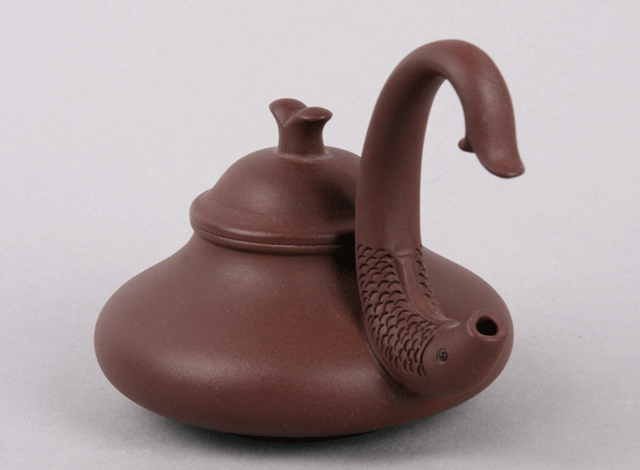
Yixing teapot; photo by B. Bernard.

Yixing teapot; photo by B. Bernard.
In the spring of 2014, John Cacciatore wrote of his trip to Yi Xing:
South of Tienanmen Square in Beijing is the theater district. Near there is a street, Liu Li Chang, famous since the Ming Dynasty (1338–1664) for the artists, artisans, poets and actors who live and gather there. Many of their creations can be seen among the paintings, tiles, bas reliefs, furnishings, and countless other architectural details that make the Imperial Palace, better known as The Forbidden City, a true palace.
Like many tourists who go to Beijing I found myself meandering through Liu Li Chang, browsing the curios, antiques, and high-quality reproductions of imperial painting, sculpture, and artifacts. The street has many art supply stores attracting artists with difficult-to-find art supplies such as rare inks, brushes, and paper.
At the west end of Liu Li Chang I was coaxed into a small tea house by a friendly couple. The simple display shelves had an unusual number of exceptional Yi Xing Tea Ceremony pots. After several hours of Chinese Tea Ceremony, sampling many varieties of tea, adding to my knowledge base of Tea Culture, and to my collection of tea and tea pots, the owners of the tea house and I established what has turned out to be a decade long friendship.
Their home town is Yi Xing, where several generations of their family were nurtured in Tea Culture and the creation of Yi Xing teapots. This is why this little tea house had such a disproportionate quantity of museum quality tea pot creations—many by family members.
After a couple of years being a frequent visitor to their tea house, and of their visiting our house, they invited us to go to Yi Xing, to meet the other members of their family and to learn of the Yi Xing traditions first hand.
There was nothing remarkable about the place as our bus entered Yi Xing. The main road had several small streets and alleyways where most shop signs advertised tea and tea culture.
One of the most remarkable things about Yi Xing is the ancient lake bed clay 10 to 12 meters below the surface. These variously colored clays, the sediments representing thousands of years of past history and culture, are the basic element from which Yi Xing pots are formed. The most famous of the clays is Purple Clay, with a dark brown or deep red hue (sometimes looking like dark eggplant) or almost black. The scent of Purple Clay is a naturally sweet earthiness. It often amuses tea pot sellers when a foreigner lifts the lid and sniffs inside a pot to sense its character. Some tea pots are intended for decoration, not for brewing tea, and have a chemical or kerosene smell. The additives give the pot a beautiful sheen, but kill the flavor. These pots probably started out as inferior clays.
One can go from studio to studio, seeing the various stages of pot making, and finding tea pots ranging from perfectly traditional to contemporary and innovative. You can buy pots for less than $50.00 U.S. or award winning, museum or imperial quality teapots worth many tens of thousands of dollars.
I was taught (and have experienced) that there is a harmony that happens between the clay and tea that influences the sniff, sip, and taste of tea served with an Yi Xing tea pot. It could be argued the harmony of clay and tea opens our senses to the best and most subtle flavors of the tea.
It is said that each Yi Xing tea pot should be used to brew just one kind of tea (but the exact match can depend on personal tastes as well as on the tea itself). Tie Guan Yin, Pu Er, and Da Hong Pau should be infused in their own pots to fully experience the best flavor of those teas. Some purists believe that Gai Wan (porcelain tea bowls with saucers and lids) deliver the most pure taste of a tea, unadulterated by the flavor of the clay of a Yi Xing tea pot. But there are others, including me, who savor the harmony delivered by the infusion of tea in a pot of high quality clay while enjoying the artistry and seemingly infinite variety of Yi Xing Tea pots.
See source code for copyright information.
Page last revised on June 16, 2014.
Please report problems to toh@unm.edu